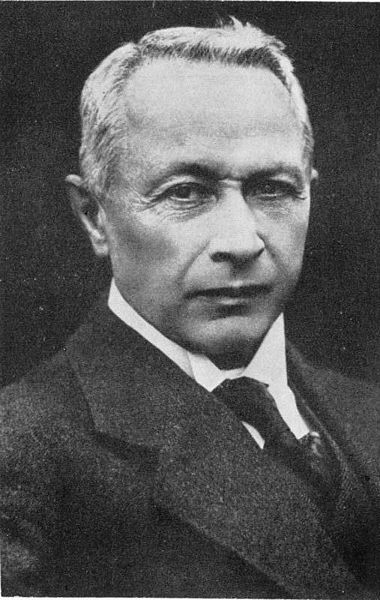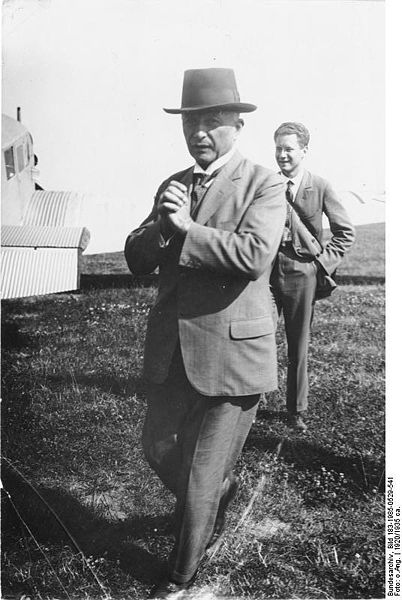<Back to Index>
- Aeronautics Pioneer Hugo Junkers, 1859
- Composer Giovanni Pierluigi da Palestrina, 1525
- Minister President of Prussia Otto Theodor von Manteuffel, 1805
PAGE SPONSOR


Hugo Junkers (3 February 1859 – 3 February 1935) was an innovative German engineer, as his many patents in varied areas (gas engines, aeroplanes) show. In 1915, he pioneered the first great change in aviation materials and design technology, away from wood and fabric materials braced by wire rigging, towards all - metal, cantilever - winged monoplane aircraft that had little to no external bracing.
Hugo Junkers is mainly known in connection with aircraft bearing his name. This includes those he reluctantly developed for the German Empire during World War I, mostly in league with Anthony Fokker, as well as civil aircraft designs during the Interwar Period produced by Junkers Flugzeugwerke (Junkers Aircraft Works). Junkers, a pacifist and not on good terms with the Nazis, deceased in 1935 and was not involved in the development of Junkers military aircraft for the Third Reich's Luftwaffe before and during World War II.
Born in Rheydt, Rhine Province, Junkers studied in Charlottenburg and Aachen.
He was a professor of mechanical engineering at Aachen between 1897 and
1912. Working as an engineer, Junkers devised, patented, and exploited
gas engines, heaters, a calorie meter and other inventions. His aeronautical work began in earnest only at the age of fifty. He had far - seeing ideas of metal aeroplanes and flying wings, but always realities of war dragged him back. During World War I the
government forced him to focus on aircraft production. In 1915, he
developed the world's first practical all metal aircraft design, the Junkers J 1 "Blechesel" (Sheetmetal
Donkey), which survived on museum display in Berlin until World War II,
and later in 1918 his firm created the world's first low - winged single
seat fighter aircraft, the Junkers D.I. However, the D.I. did not enter production until 1918. He also produced a two seat fighter (pilot and rear gunner), the Junkers CL.I. and an armored - fuselage two seat all metal sesquiplane, the Junkers J.I,
considered the best German ground attack aircraft of the war. The J.I's
pattern of an armored fuselage that protected the nose mounted engine,
pilot and observer in a unitized metal "bathtub", was the possible
inspiration for Sergei Ilyushin's later IL-2 Shturmovik (conceivably appropriate as Junkers did have a manufacturing plant in Fili, a suburb of Moscow, in the Soviet Union in the 1920s) with a similar armored fuselage design, and Soviet aviation pioneer Andrei Tupolev and American aviation designer William Stout each owed much to Hugo Junkers in the designs of their earlier aircraft,
which benefitted from Junkers' corrugated light metal construction philosophy. The Junkers F.13 from 1919 was the first of several successful civil aircraft designs of Junkers Flugzeugwerke including the Junkers Ju 52/3m from
1932. Through a variety of business initiatives Junkers was also active
in founding and developing airlines around the globe initially aiming
to sell its aircraft. Airlines where Junkers played a pivotal role in
early phases of their development include Deutsche Luft Hansa and Lloyd Aéreo Boliviano.
However, several business ventures failed from wider economic or
political problems that hamstrung sound engineering plans. But Junkers
always had more ideas: the massive four engined G.38,
nicknamed "Der Grosse Dessauer", delivered to Luft Hansa made no
commercial trips for many months as he repeatedly recalled it to the
factory for improvements. Junkers was a socialist and a pacifist.
For these reasons, he had several occasions to cross swords with German
leadership. In 1917 the government forced him into partnership with
Anthony Fokker to ensure wartime production targets would be met. During
the 1920s in Germany and among Junkers' employees a wide spectrum of
political views was present. About every aspect of the business, and of
its environment, there were differing opinions. For members of all the
many groups represented in Junkers, aviation offered hope for national
renewal. Their varied views led to lively internal corporate politics.
In 1926, unable to make government loan repayments after a failed
venture to build planes for the USSR, he lost control of most of his businesses. In 1933 the new Nazi government
interfered and, on taking power, immediately demanded ownership of
Junkers' patents and control of his remaining companies. Under threat
of imprisonment he eventually acquiesced, to little avail; a year later
he was under house arrest; a year after that he was dead.